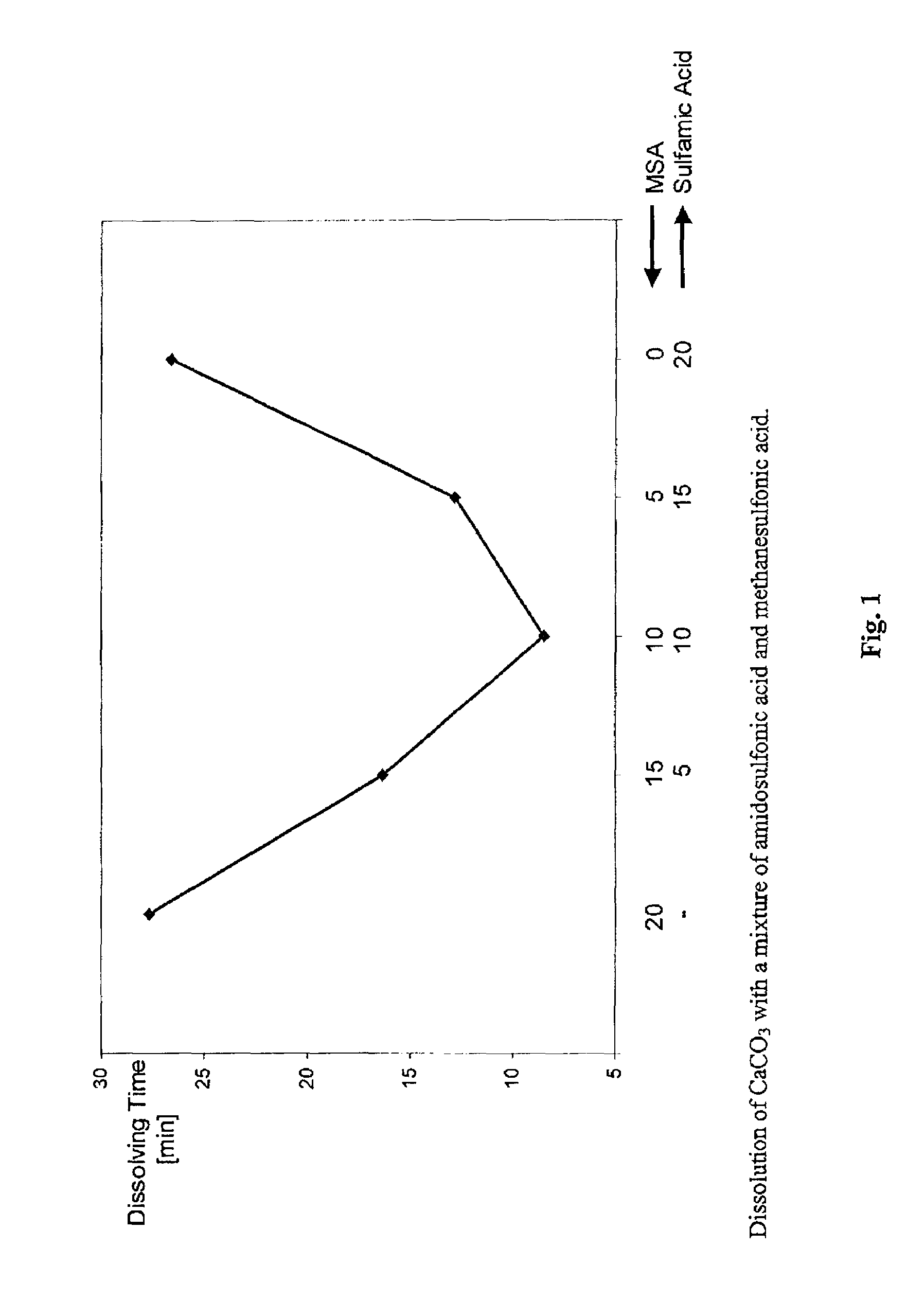Methods of increasing permeability in carbonatic rock formations with alkanesulfonic acids
a technology of carbonatic rock and alkanesulfonic acid, which is applied in the field of alkanesulfonic acids, can solve the problems of affecting the porosity of the rock formation is already too low, and the pores which are sufficiently large per se may become blocked by particles, etc., and achieve the effect of increasing the permeability of carbonatic or carbonate-containing formations
- Summary
- Abstract
- Description
- Claims
- Application Information
AI Technical Summary
Benefits of technology
Problems solved by technology
Method used
Image
Examples
example 1
Dissolution Rate for CaCO3
[0056]10 ml of acid were added to 240 ml of a 0.104 molar CaCO3 suspension under the conditions stated in table 1, and the time to complete dissolution of the CaCO3 was measured. The respective acids were used in an equimolar ratio. The values were determined in each case with and without stirring. The data are listed in table 1.
[0057]
TABLE 1Dissolution rate for CaCO3 [data in minutes]DissolutionRelative dissolutionAmounttime [min]time [MSA = 100%][% by weight]withoutwithwithoutAcidin waterstirringstirringstirringwith stirringTemperature: 23° C.MSA70108623.2100%100%HCl26.5105836.097.4% 155%HCOOH33.5>576047.3>530% 204%Temperature: 40° C.MSA7016211.7100%100%HCl26.523933.3148%285%HCOOH33.5>54028.1>333% 240%Temperature: 68° C.MSA70574.5100%100%HCl26.58113.1142%291%HCOOH33.537837.2663%827%
example 2
Comparison Between the Corrosion Rates of Hydrochloric and Methanesulfonic Acid
[0058]The corrosion rate was determined by the action of acid on a steel test specimen. The test specimen used was steel having the maternal number 1.0425.
[0059]The material removed per unit area was determined by weighing before and after the action of the acid (cf. table 2):
[0060]
TABLE 2Corrosion rate of steel in HCl and MSA (90 min, 75° C.)Material removedAcid[g / cm2]HCl [26.55]1.60MSA [70.00]0.08
example 3
Corrosion Rates of Hydrochloric and Methanesulfonic Acid in the Presence of Inhibitors
[0061]The following inhibitors were used for the tests:
[0062]
TypeDescriptionAModified polyacrylic acidBCopolymer based on maleic acid / acrylic acid / vinylphosphonic acidCPropargyl alcoholDPropargyl alcohol alkoxylated
[0063]The corrosion rates were determined as described in example 2. The results are listed in each case in tables 3 and 4.
[0064]
TABLE 3Corrosion rate of steel in MSA / HCl in the presence ofinhibitors (60 min, 75° C.)AcidInhibitorConcentrationg / cm2HCl 26.5%none—1.325HCl 26.5%A1%1.263HCl 26.5%B1%1.083HCl 26.5%C1%0.003HCl 26.5%D1%0.001MSA 70%none—0.073MSA 70%B1%0.048MSA 70%A1%0.040MSA 70%D1%0.003MSA 70%C1%0.002
[0065]
TABLE 4Corrosion rate of steel in MSA / HCl in the presence of inhibitors(180 min, 75° C.)AcidInhibitorConcentrationg / cm2HCl 26.5%—a)MSA 70%—0.137HCl 26.5%A0.5%a)MSA 70%A0.5%0.132HCl 26.5%D0.67% a)MSA 70%D0.67% 0.005HCl 26.5%B0.5%a)MSA 70%B0.5%0.098a) Test specimen was completely ...
PUM
| Property | Measurement | Unit |
|---|---|---|
| temperature | aaaaa | aaaaa |
| pressure | aaaaa | aaaaa |
| temperatures | aaaaa | aaaaa |
Abstract
Description
Claims
Application Information
 Login to View More
Login to View More - R&D
- Intellectual Property
- Life Sciences
- Materials
- Tech Scout
- Unparalleled Data Quality
- Higher Quality Content
- 60% Fewer Hallucinations
Browse by: Latest US Patents, China's latest patents, Technical Efficacy Thesaurus, Application Domain, Technology Topic, Popular Technical Reports.
© 2025 PatSnap. All rights reserved.Legal|Privacy policy|Modern Slavery Act Transparency Statement|Sitemap|About US| Contact US: help@patsnap.com

